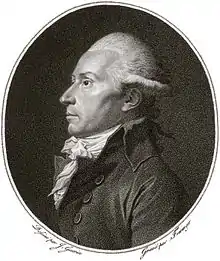Pierre Victor, baron Malouet
Pierre Victor, baron Malouet (11 February 1740 – 7 September 1814), was a French colonial administrator, planter, conservative publicist and monarchist politician, who signed as an émigré the Whitehall Accord.

Life
Malouet was born in Riom as the son of a bailli in Puy-de-Dôme. He was educated at the College of Juilly (1754–1756) before studying law. Then he opted for a career in the diplomatic service and in 1758 he was sent to the French Embassy in Lisbon and met with the Marquis de Pombal. When he returned to France he was given an administrative role in the French Army under the Duc de Broglie.[1] In 1763 he was appointed intendant at Rochefort and became commissary in San Domingo in 1767. There he married and acquired a significant number of sugar plantations. He returned to France in 1774, and took up the role of commissary-general of the navy. In 1776 he was entrusted to carry out plans of improving the colonization of French Guiana. The next year Malouet and his wife made a 7-week trip to Paramaribo, to discuss the 200 Maroon that had fled from Surinam to Guiana.[2] Malouet criticized the way the Dutch treated their slaves after he had visited 26 plantations. To improve relations between the owners and the slaves, Malouet "promoted" religion. He was almost taken prisoner during the American War of Independence by an English corsair on his return to Cayenne.[3]

Back in France he was well received at court, and the execution of his plans in Guiana was assured. Malouet was appointed intendant of the port of Toulon. In 1788 he published his Mémoire sur l'esclavage des négres opposing Abbé Raynal, who advocated the abolition of slavery. Malouet took a seat as representative of the Third Estate for his home town in the Estates General of 1789, where he soon became well known as a defender of the monarchy. In September 1792, after the besiege of the Tuileries palace, he emigrated to England, and met with Edmund Burke. On behalf of San Domingue he signed the Whitehall Accord, which placed the colony (along with Guadeloupe and Martinique) under the authority of the British Empire, whilst ensuring the profitability of the sugar plantations by overturning the recent French declaration abolishing slavery. Around December 1792 he sought in vain permission to return to assist in the defence of Louis XVI.
After the 18 Brumaire he returned to France. In 1801 his name was erased from the list of emigres by Napoleon; in 1803, after the Saint-Domingue expedition he was sent to Antwerp as commissioner-general and maritime prefect to supervise the erection of defence works, and the creation of a fleet. Malouet left the city in 1807. He was peered and entered the council of state for the navy in 1810. Having offended the emperor by his criticism of the campaign in Russia, he was disgraced and left office in 1812. At the Restoration, Louis XVIII made him Minister of the Navy, but Malouet died the same year. His memoires were published in 1868.
Malouet was the author of a lengthy prose poem with a nautical theme, Les quatre parties du jour à la mer, published in 1783.
Works
- Collection de ses opinions à l'Assemblée Nationale (3 vols., 1791–1792)
- Collection de mémoires et correspondences officielles sur l'administration des colonies et notamment sur la Guerre française et hollandaise (5 vols. 1802)
- Mémoire sur l'esclavage des negres dans les possessions françaises (Paris, 1788)
- Examen de cette question: Quel sera pour les colonies de l'Amerique le resultat de la revolution française? (London, 1797).
- Les quatre parties du jour à la mer (Paris, 1783)
References
- Gallois L. (1825) Biographie de tous les ministres: depuis la constitution de 1791, jusqu'au notre jours
- "1789-1815 Malouet". 24 January 2023.
- V.P. Malouet’s Reisen nach dem französischen Guiana und nach Surinam, p. 116. Auszugsweise aus dem Französischen uebersetzt [von T.F. Ehrmann] (1805) Bibliothek der neuesten und wichtigsten Reisebeschreibungen
Sources
- Wilson, J. G.; Fiske, J., eds. (1900). . Appletons' Cyclopædia of American Biography. New York: D. Appleton.
- Attribution
- This article incorporates text from a publication now in the public domain: Chisholm, Hugh, ed. (1911). "Malouet, Pierre Victor, Baron". Encyclopædia Britannica. Vol. 17 (11th ed.). Cambridge University Press. p. 497.
.JPG.webp)